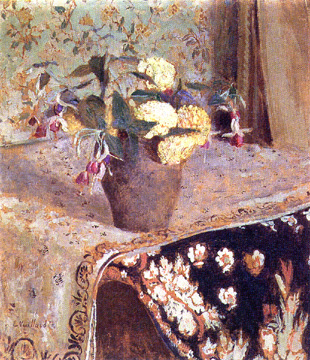
Edouard Vuillard
French, 1868-1940
Fuchsias and French Marigolds, 1903
oil on cardboard
18 1/2 × 16 1/2 in.
SBMA, Gift of Millicent A. Rogers in honor of Ala Story
1953.28

Edouard Vuillard, Self-Portrait, Aged 21, 1889, Oil on canvas, National Gallery of Art, Washington DC
“I do not belong to any school; I simply want to do something that is personal to my self. “
Edouard Vuillard
RESEARCH PAPER
While still life is atypical subject matter for Edouard Vuillard, the medium, oil on cardboard (probably learned from Toulouse-Lautrec) in "Fuchsias and Violets of India" is typical of his Oeuvre. This work is not precisely dated, but judging from the restrained palette, the rather literal conception of the flowers and the decorative detailing, it appears to have been done later in Vuillard's artistic career. His earlier work was much more abstract and coloristic.
In his early years as an artist, as a member of the later 19th century Ecole de Paris, Vuillard was one of a group of painters influenced by Gauguin's expressive use of color and pattern. In addition to Buillard, the group included Paul Serusier, Pierre Bonnard, Toulouse-Lautrec, Felix Vallotton, Maillol, before he took up sculpture, as well as other artists. This artistic fraternity known as the Nabis, a name coined by the poet Cazalis from a Hebrew word meaning "prophet", was dedicated to such credos as appearance shouldn't be reproduced in a literal manner and color can and should be used in a decorative and arbitrary way. Perhaps the statement made by Maurice Denis, one of the group's spokesmen, "a picture - before being a horse, a nude or an anecdote - is essentially a flat surface covered with colors assembled in a certain order" , best summarizes the Nabi aesthetic. After a few years and several exhibitions, the Nabis gradually disbanded. This post-impressionistic period was one of "aesthetic turmoil"', when art movements were pulling in different directions. No doubt Nabi theory left an imprint on Vuillard's style, but he was also influenced by the painting of Redon, the late work of Degas and by the Japanese print. From this eclectic turbulence, Vuillard distilled a highly original style, creating his own idiom as evidenced in this still life.
Is it a poster? Or tapestry? Or something in between? The viewer might ask himself these questions when first confronted with this work. Like a gothic tapestry or an early Netherlandish panel painting, the flowers in the vase are wrought with botanical precision. They seem to exist in three-dimensional space based on natural observation. The overall patterning of the composition creates a tapestry-like effect. Adhering to Nabi dictum in the importance of the background to the general design, the surface is broken-up with bordered patches, punctuated with decorative forms. Unlike the treatment of the flowers in the vase, these elegant linear arabesques enliven the ground, accentuating two-dimensional values. There's almost a playfulness I n the rendering of space. Yet, there's something poster-like too in the flat areas of low-keyed colors with an occasional vivid contrast, as in the sharp yellow in the upper left-hand portion. Even when bright hues are used, they are muted. Pigment appears to have been applied thinly. Though done I n oil, it almost seems like a print. The whole effect is one of "serene restraint."
Vuillard, unlike his contemporary Redon, who attached mystical and poetic meaning to his flower subjects in keeping with still life tradition, deliberately eliminates the esoteric and/or spiritual. Rather the subject matter assumes an almost subsidiary position to the rest of the composition. Interest appears to be in creating a new disposition of shapes and forms. Perhaps the subject is one of pictorial values.
Edouard Vuillard is best known for quiet, but luminous interior scenes of daily life, featuring people, generally women, going about daily tasks such as dressing, reading, sewing, conversing or merely daydreaming. It was a world he knew well. He never married and was totally devoted to his mother, with whom he lived, until her death in 1928. His father had died when he was a child. Artistically active all of his life, he exhibited at the gallery of his dealer Bernheim Jeune, at the Salon des Independants and at the Salon d'Automne of which he was a founding member. Two years before his death, he did the decorations "Allegorie de la Paix" for the Palais des Nations at Geneva.
Alvard, J. "Paris", Art News, Vol. 67, Oct. 1968
Canaday, J. , Mainstreams of Modern Art, Simon & Schuster, Inc., N.Y., 1959
History of Modern Painters, Baudelaire to Bonnard, Raynal, 1949
"Notable Works of Art Now on the Market", Burlington Magazine, Vol.CIII, Dec. 1961
Oxford Companion to Art, Oxford University Press, Great Britain
Preston, Stuart, Vuillard, Harry Abrams, Inc. N.Y.
"Round the Galleries", Connoisseur, Vol. CXLIII, April, 1959
Prepared for the Docent Council of Santa Barbara Museum of Art by Norma Crawford
Website Preparer, Nyna Mahan
COMMENTS
Prior to 2011, this painting was titled Fuchsias et oeillets d'inde (Fuchsias and Carnations of India), ca. 1900, and dated slightly earlier.
SBMA CURATORIAL LABELS
Although best known for his intimate interior scenes, Vuillard concentrated on still lifes at several periods of his career. This luminous image of a bouquet of fuchsias and French marigolds on a table draped with richly patterned fabrics is typical of the still lifes he painted around the turn of the century. The son of a corset maker, Vuillard had been surrounded since childhood by a kaleidoscopic array of different textiles and developed an early interest in decorative pattern, which remained a guiding concern throughout much of his work. Here, the overlapping patterns flatten the picture space, giving it the appearance of a tapestry rather than a painting.
- Ridley-Tree Reinstallation, 2022
